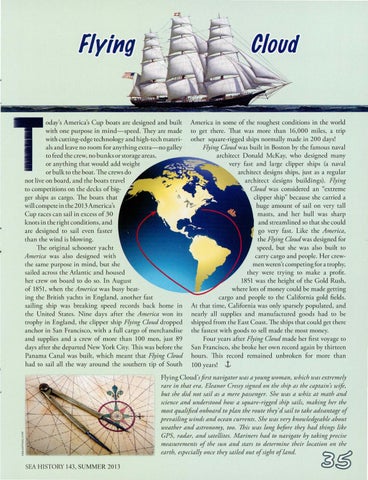J -
Flying oday's America's Cup boats are designed and built with one purpose in mind-speed. They are made with cutting-edge technology and high-tech materials and leave no room for anything extra-no galley to feed the crew, no bunks or storage areas, or anything that would add weight or bulk to the boat. The crews do not live on board, and the boats travel to competitions on the decks of bigger ships as cargo. The boats that will compete in the 2013 America's Cup races can sail in excess of 30 knots in the right conditions, and are designed to sail even faster than the wind is blowing. The original schooner yacht America was also designed with the same purpose in mind, but she sailed across the Atlantic and housed her crew on board to do so. In August of 1851, when the America was busy beating the British yachts in England, another fast sailing ship was breaking speed records back home in the United States. Nine days after the America won its trophy in England, the clipper ship Flying Cloud dropped anchor in San Francisco, with a full cargo of merchandise and supplies and a crew of more than 100 men, just 89 days after she departed New York City. This was before the Panama Canal was built, which meant that Flying Cloud had to sail all the way around the southern tip of South
America in some of the roughest conditions in the world to get there. That was more than 16,000 miles, a trip other square-rigged ships normally made in 200 days! Flying Cloud was built in Boston by the famous naval architect Donald McKay, who designed many very fast and large clipper ships (a naval architect designs ships, just as a regular architect designs buildings). Flying Cloud was considered an "extreme clipper ship" because she carried a huge amount of sail on very tall masts, and her hull was sharp and streamlined so that she could go very fast. Like the America, the Flying Cloud was designed for speed, bur she was also built to carry cargo and people. Her crewmen weren't competing for a trophy, they were trying to make a profit. 1851 was the height of the Gold Rush, where lots of money could be made getting cargo and people to the California gold fields. At that time, California was only sparsely populated, and nearly all supplies and manufactured goods had to be shipped from the East Coast. The ships that could get there the fastest with goods to sell made the most money. Four years after Flying Cloud made her first voyage to San Francisco, she broke her own record again by thirteen hours. This record remained unbroken for more than 100 years! ,!,
Flying Cloud's first navigator was a young woman, which was extremely rare in that era. Eleanor Cressy signed on the ship as the captain's wife, but she did not sail as a mere passenger. She was a whiz at math and science and understood how a square-rigged ship sails, making her the most qualified onboard to plan the route they'd sail to take advantage of prevailing winds and ocean currents. She was very knowledgeable about weather and astronomy, too. This was long before they had things like GPS, radar, and satellites. Mariners had to navigate by taking precise measurements of the sun and stars to determine their location on the earth, especially once they sailed out ofsight of land. SEA HISTORY 143, SUMMER 2013
